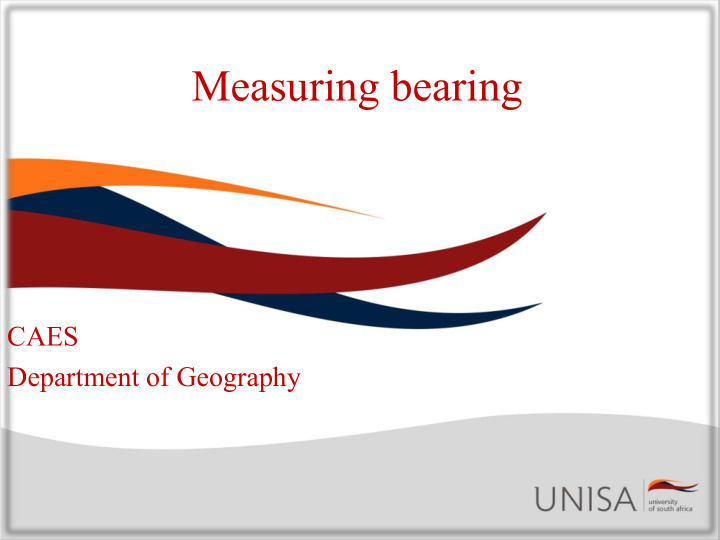



Measuring bearing CAES Department of Geography
Why do we want to know bearing? Imagine you have to describe the location of a point, somewhere on a map? Location can be described in 2 ways: i. The coordinates, in terms of latitude and longitude ii. The location of a place, relative to another location ( the distance and direction to the location) Let us use point X as in example, how could you tell someone where it is without a GPS? For example, I am at point X, how would you be able to find me? X
If we had some reference point that we could describe the location of point X, relative to our reference point, we would know where to find point X. Thus, if you were at Trig Beacon 1, and I would have to explain my whereabouts to you (at point X), I would be able to say, that: I am south of your location. 1 I thus use direction to describe my location, relative to your location X
Direction in the real world is however much more complex than only north, south, east or west. If I only tell you south, and your measurement is wrong by only a few degrees, you would completely miss me 1 X We thus make use of an exact angle to measure the direction, and we refer to this angle as BEARING.
Measuring Bearing • Measure the Bearing on B from A: Bearing is ALWAYS TN 0° measured from 0°, and A True North and 0° 90° 270° always coincides 180° B 1. When measuring bearing, you 1 st have to make sure FROM which point to measure 2. Connect the points that you want to measure. 3. Place your protractor in such a way that you start measuring from 0°. Make sure that the line is vertical, and not skew 3. To Measure TRUE BEARING, Measure clockwise from 0° to the line connecting the other points
True Bearing and Magnetic Bearing Because of the difference in direction between true north (the direction that all the lines of longitude pint to) and magnetic north (the line that all compass lines point to, because of the earth’s electrical currents) , we also distinguish between true bearing and magnetic bearing. If we were to place a compass on a topographical map (correctly orientated) the compass would not point in the same direction as the lines of longitude, but would deviate slightly. This deviation from true north, is known as magnetic declination, and could either deviate east or west of true north.
Magnetic Bearing In order to calculate magnetic bearing, we first have to calculate the true bearing. Magnetic Bearing = True Bearing + Magnetic Declination It is important to remember that declination can be east or west Declination west of true north Declination east of true north MN MN 0° 0° 90° 90° 270° 270° 180° 180°
Declination west of true north Declination east of true north MN MN 0° 0° 90° 270° 90° 270° 180° 180° Declination east of true north Declination east of true north will make your angle of will make your angle of measurement larger, thus measurement smaller, thus Magnetic bearing = true Magnetic bearing = true bearing + Declination bearing - Declination
Example # 1 • Let us measure the bearing MN A 0° on B from A: 90° 270° Let’s pretend that it is: B 180° 245° THUS: The true bearing on B from A is 245° If the magnetic declination is 7° west, what is the magnetic bearing on A from B? Remember, our angle of measurement increases with a declination that is WEST of true north Magnetic bearing: 245° + 7° = 252°
Example # 2 The magnetic declination in 2005, was 6° east, the average change is 3’ east. What is the magnetic bearing on D from E in 2009 D 1. Let us measure the bearing E 0° Let’s pretend that it is: 300° on D from E: 90° 270° THUS: The true bearing on D from E is 300° 180° 2. We need to calculate what the current magnetic declination is: Note that both the annual Difference in years: 2009 – 2005: 4 years change, and the declination is Annual change: 3’ east in the same direction (east), 3’ × 4years = 12’ east thus we add the annual change to the declination 6° east + 12’ east = 6 degrees and12 minutes east Remember, our angle of measurement decreases with a declination that is EAST of true north Magnetic bearing: 300° - 6° 12’ = 293 ° 48’
Example # 3 The magnetic declination in 2006, was 8° west, the average change is 15’ east. What is the magnetic bearing on C from A in 2009 1. Let us measure the bearing A 0° Let’s pretend that it is: 120° on D from E: 90° 270° THUS: The true bearing on D from E is 120° C 180° 2. We need to calculate what the current magnetic declination is: Difference in years: 2009 – 2006: 3 Note that both the annual change, and the declination is Annual change: 15’ east in the same direction (east), 15’ × 3 years = 45’ east thus we add the annual change 8° west - 45 ’ east = 7 degrees and 15 minutes west to the declination Remember, our angle of measurement increases with a declination that is WEST of true north Magnetic bearing: 120° + 7° 15’ = 127 ° 15’
Recommend
More recommend